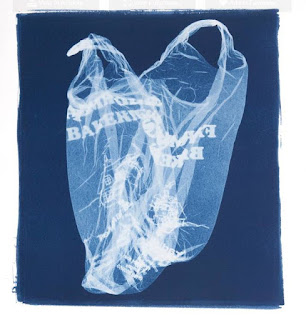DART1131 - WEEK 1-3 Photogram Process & Concept development
WEEK 1-3
Week 1 - An introduction on the history of photography as well as camera-less photography was given. We went through the works of some artists in class as a starting point to begin the development of assessment 1 --- See What Will Happen (which is based on the idea of chance and the fluidity and uniqueness of camera-less photography works).
Week 2 - After a demonstration on the photogram process and film processing procedure was given, I started to the experiment with the film paper by exposing it to different length of time with a set aperture. I made two test strips and i was quite happy with the gradient of shades that resulted on the film papers.
(By placing a layer of bubble warp on the film paper and moving the glass cup before each exposure ---2 seconds, I exposed the film paper for a total of 8 seconds, and was able to created this image that seems to capture a movement)
(Another two test strips that I made during week 2 studio, the first one was created by exposing different layers of bubble warp under different length of exposure. The second one was placing solid plastic toy on the film paper and exposed for 8 seconds, covered the object with scrunched plastic wrapping paper and exposed again for another 4 seconds. I really like the strong contrast between the black and white shade created by the solid toy and the film paper, as well as the texture of plastic that was left on the silhouette of the toy)
With more research on photographer and artists, I was intrigued by the work of two artists which explore on similar subject matters with their works --- Rachel Thomson and Richard Freestone.
Thomson focus on the concepts of mass production and wasteful culture with photograms that capture ambiguous creatures made from plastic waste that was remove from the environment. She also created series of work by placing plastic waste next to native plants.
(Photograms created by Thomson --- http://www.rachelthomsonstudio.co.uk/photography.html)
While Freestone focus on the devastated effect of plastic waste invasion on marine species.
(This is not a Jelly Fish --- Richard Freestone,
Hence, I set my focus on the concept of PARADOX, as most people are aware of the many impacts of plastic pollution but often don't see the immediate effect on our everyday lives. This also allures into the push and pull relationship between the many ongoing campaigns that aim to reduce plastic consumption and high demand on plastic products in the market.
WEEK 3 - With a clearer concept in mind, I started to gather materials that I can use for my photograms. I collected all sorts of plastic products in my house including plastic lunch bags, plastic wrapping paper, coffee cups, earphones, toys and plastic gloves.
During week3's studio, I focused on finalising my body of work for the assessment. To create my images, I mainly used the method of overlapping my objects, as well as moving/adding/removing some of them during/before each exposure, hence to mimic the effect of intertwined plastic waste drifting in the ocean. For the first few photograms, I seem to exposed them for too long so they turned out tobe dark and lack of highlights, as most of the materials had high transparency. I tried to improve on my approach to create the images by adjusting the aperture to be lower and placed extra translucent material on the areas where I wanted to keep the highlights. I also tried to shorten the exposure time to avoid the images being to dark. Overall I was happy with the outcome of the images.
The concept of chance was explored mostly within the process of creating the photograms as I was new to the procedure of darkroom photography. A lot of mistakes were made along the way, but in a sense it also provided the photograms with their uniqueness and vulnerability. I was really fascinated by the interaction between the object, the light and the film paper within the 6-8 second exposure, which emphasis the notion of chance.



















Comments
Post a Comment